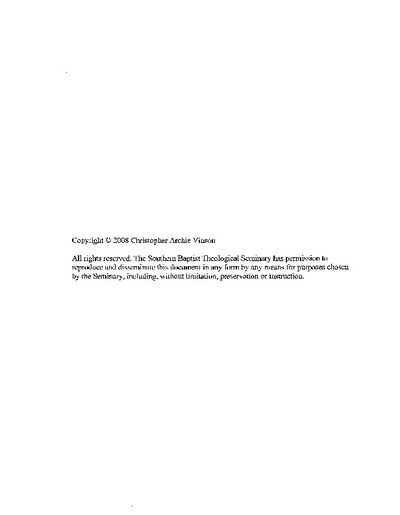| dc.description.abstract | One of the fundamental issues at the core of evangelical ethical debates involves the use of Scripture. Rejecting historical-critical methods on the one hand, and simplistic prooftexting on the other. Richard Hays wrote The Moral Vision of the New Testament in order to deal with this very problem. By most accounts, Hays's approach succeeds. This dissertation explores the method proposed by Hays in The Moral Vision , seeking to locate the strengths of his approach while noting its primary weaknesses. Upon finding Hays's method wanting, the dissertation posits a constructive proposal, in conversation with Hays, for using Scripture in ethics.
The first chapter of the dissertation introduces the problem and suggests The Moral Vision as an ethical text which has garnered sufficient accolades as to make it worthy of examination. Chapter 2 seeks to describe in detail the major lines of argument, giving specific attention to the method Hays proposes to use Scripture in ethics.
Chapter 3 offers a critique of The Moral Vision , beginning with several strengths. The thrust of the chapter, however centers on the following four weaknesses of Hays's method: first, Hays's program of appropriating Scripture is built on his view that Scripture speaks in disunity; second, that view of the canon necessitates that Hays identify three focal images to locate a coherent moral voice. The focal images serve to develop, despite Hays insistence to the contrary, a canon within the canon; third, Hays gives priority to narrative in his system, which opens his method up to greater subjectivity and personal bias; and lastly, Hays's approach provides no criteria for judging whether an appropriation is faithful, it unwittingly relies on transcendent ethical principles, and it fails to distinguish between interpretation and application.
After offering a critique of The Moral Vision , chapter 4 proposes an original method for appropriating Scripture in ethics. That proposal seeks first to establish foundational convictions regarding Scripture and ethics. Building on those presuppositions, the dissertation prescribes how one might rightly read the ancient text of Scripture and from there draw conclusions about how the Bible gives ethical instructions today. At every turn, the dissertation's interest is concerned primarily with methodology rather than specific ethical conclusions. The chapter closes by drawing conclusions about one contemporary ethical issue ( in vitro fertilization) in order to test the method prescribed and help the reader see how such a proposal might proceed.
The final chapter proposes application for the church that arises from the method proposed by this dissertation. The chapter also raises tensions for further research which lay outside the scope of this dissertation's purposes. | en_US |

